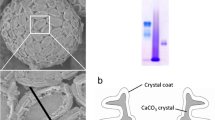Summary
Polyanions are postulated intermediates in biomineralization because they sequester large numbers of calcium ions and occur in high concentrations at mineralizing foci in distantly related organisms. In this study mineral ion and polyanion metabolism was examined inPleurochrysis carterae to determine whether polyanions function as intermediate calcium-carriers during coccolith (mineralized scale) formation. In this organism mineralization occurs intracellularly in coccolith-forming saccules, and mature coccoliths are extruded through the plasma membrane into the coccosphere. The polyanions (acidic polysaccharides known as PS-1 and PS-2) are synthesized in medial Golgi cisternae and transported to the coccolith-forming saccule prior to the onset of mineral deposition; they also cover the mineral surface of mature coccoliths. Pulse-chase experiments with45Ca2+ and14CO3 − show the calcium uptake into the coccolith-forming saccule is much slower than carbonate uptake. The extended intracellular half-life of calcium ions destined for the coccosphere suggests that calcium is initially sequestered in more distal Golgi elements (perhaps in association with the polyanions) and enters the coccolith-forming saccule only after passage through the endomembrane system. This is consistent with previous cytochemical studies showing that the polyanions are complexed with calcium prior to mineral deposition. It has been suggested that polyanions may be degraded at the mineralization front in order to free calcium ions for precipitation with available carbonate or phosphate ions. However, this study demonstrates that the polyanions are not degraded; essentially all PS-1 and PS-2 are eventually secreted with the mineral phase into the coccosphere. The kinetics of mineral ion and polyanion secretion are consistent with a polyanion-mediated calcium transport; however, the manner in which calcium might be sequestered by and freed from the polyanions is still obscure.
Similar content being viewed by others
Abbreviations
- PS-1/2/3:
-
polysaccharide 1/2/3
- EDTA:
-
ethylenediaminetetraacetic acid
- TCA:
-
trichloroacetic acid
References
Blumenkrantz N, Asboe-Hansen G (1973) New method for quantitative determination of uronic acids. Anal Biochem 54: 484–489
Crenshaw MA (1982) Mechanisms of normal biological mineralization of calcium carbonate. In: Nancollas GH (ed) Biological mineralization and demineralization. Springer, Berlin Heidelberg New York, pp 243–357
Dimuzio MT, Veis A (1978) The biosynthesis of phosphophoryns and dentin collagen in the continuously erupting rat incisor. J Biol Chem 353: 6845–6852
Guillard RRL (1975) Culture of phytoplankton for feeding marine invertebrates. In: Smith WL, Chanley MH (eds) Culture of marine invertebrate animals. Plenum, New York, pp 29–60
Kwon DK, Gonzalez EL (1994) Localization of Ca2+-stimulated ATPase in the coccolith-producing compartment of cells ofPleurochrysis sp. (Prymnesiophyceae). J Phycol 30: 689–695
Laemmli UK (1970) Cleavage of structural proteins during the assembly of the head of bacteriophage T4. Nature 227: 680–685
Lee SL, Veis A, Glonek T (1977) Dentin phosphoprotein: an extracellular calcium-binding protein. Biochemistry 16: 2971–2979
Lyman J, Fleming RH (1940) Composition of sea water. J Marine Sci 3: 134–146
Marsh ME (1989) Self-association of calcium and magnesium complexes of dentin phosphophoryn. Biochemistry 28: 339–345
— (1994) Polyanion-mediated mineralization — assembly and reorganization of acidic polysaccharides in the Golgi system of a coccolithophorid alga during mineral deposition. Protoplasma 177: 108–122
—, Sass RL (1983) Calcium-binding phosphoprotein particles in the extrapallial fluid and innermost shell lamella of clams. J Exp Zool 226: 193–203
—, Chang DK, King GC (1992) Isolation and characterization of a novel acidic polysaccharide containing tartrate and glyoxylate residues from the mineralized scales of a unicellular coccolithophorid algaPleurochrysis carterae. J Biol Chem 267: 20507–20512
Outka DE, Williams DC (1971) Sequential coccolith morphogenesis inHymenomonas carterae. J Protozool 18: 285–297
van der Wall P, de Jong EW, Westbroek P, de Bruijn WC, Mulder-Stapel AA (1983a) Polysaccharide localization, coccolith formation and Golgi dynamics in the coccolithophoridHymenomonas carterae. J Ultrastruct Res 85: 139–158
— — — —, (1983b) Calcification in the coccolithophorid algaHymenomonas carterae. In: Hallberg R (ed) Environmental biogeochemistry. Swedish Research Council, Stockholm, pp 251–258 (Ecological Bulletin, vol 35)
Author information
Authors and Affiliations
Rights and permissions
About this article
Cite this article
Marsh, M.E. Polyanion-mediated mineralization — a kinetic analysis of the calcium-carrier hypothesis in the phytoflagellatePleurochrysis carterae . Protoplasma 190, 181–188 (1996). https://doi.org/10.1007/BF01281317
Received:
Accepted:
Issue Date:
DOI: https://doi.org/10.1007/BF01281317




